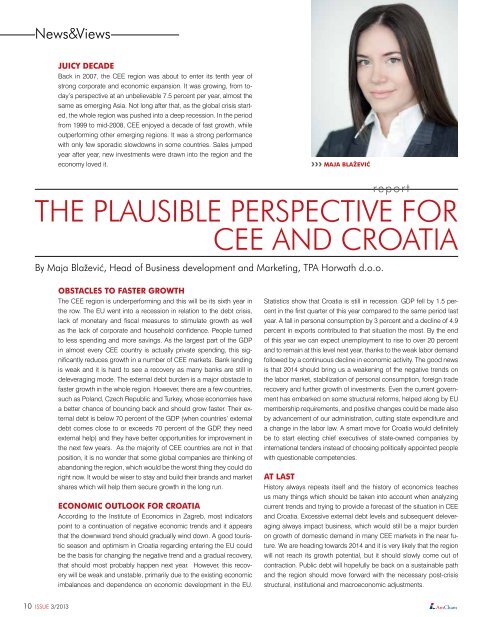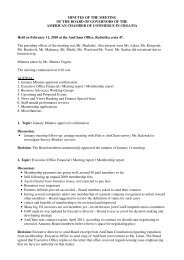No. 3 / 2013 - AmCham
No. 3 / 2013 - AmCham
No. 3 / 2013 - AmCham
- No tags were found...
You also want an ePaper? Increase the reach of your titles
YUMPU automatically turns print PDFs into web optimized ePapers that Google loves.
News&ViewsJuicy DecadeBack in 2007, the CEE region was about to enter its tenth year ofstrong corporate and economic expansion. It was growing, from today’sperspective at an unbelievable 7.5 percent per year, almost thesame as emerging Asia. <strong>No</strong>t long after that, as the global crisis started,the whole region was pushed into a deep recession. In the periodfrom 1999 to mid-2008, CEE enjoyed a decade of fast growth, whileoutperforming other emerging regions. It was a strong performancewith only few sporadic slowdowns in some countries. Sales jumpedyear after year, new investments were drawn into the region and theeconomy loved it.››› maja blaževićThe Plausible Perspective forCEE and CroatiaBy Maja Blažević, Head of Business development and Marketing, TPA Horwath d.o.o.reportObstacles to Faster GrowthThe CEE region is underperforming and this will be its sixth year inthe row. The EU went into a recession in relation to the debt crisis,lack of monetary and fiscal measures to stimulate growth as wellas the lack of corporate and household confidence. People turnedto less spending and more savings. As the largest part of the GDPin almost every CEE country is actually private spending, this significantlyreduces growth in a number of CEE markets. Bank lendingis weak and it is hard to see a recovery as many banks are still indeleveraging mode. The external debt burden is a major obstacle tofaster growth in the whole region. However, there are a few countries,such as Poland, Czech Republic and Turkey, whose economies havea better chance of bouncing back and should grow faster. Their externaldebt is below 70 percent of the GDP (when countries’ externaldebt comes close to or exceeds 70 percent of the GDP, they needexternal help) and they have better opportunities for improvement inthe next few years. As the majority of CEE countries are not in thatposition, it is no wonder that some global companies are thinking ofabandoning the region, which would be the worst thing they could doright now. It would be wiser to stay and build their brands and marketshares which will help them secure growth in the long run.Economic Outlook for CroatiaAccording to the Institute of Economics in Zagreb, most indicatorspoint to a continuation of negative economic trends and it appearsthat the downward trend should gradually wind down. A good touristicseason and optimism in Croatia regarding entering the EU couldbe the basis for changing the negative trend and a gradual recovery,that should most probably happen next year. However, this recoverywill be weak and unstable, primarily due to the existing economicimbalances and dependence on economic development in the EU.Statistics show that Croatia is still in recession. GDP fell by 1.5 percentin the first quarter of this year compared to the same period lastyear. A fall in personal consumption by 3 percent and a decline of 4.9percent in exports contributed to that situation the most. By the endof this year we can expect unemployment to rise to over 20 percentand to remain at this level next year, thanks to the weak labor demandfollowed by a continuous decline in economic activity. The good newsis that 2014 should bring us a weakening of the negative trends onthe labor market, stabilization of personal consumption, foreign traderecovery and further growth of investments. Even the current governmenthas embarked on some structural reforms, helped along by EUmembership requirements, and positive changes could be made alsoby advancement of our administration, cutting state expenditure anda change in the labor law. A smart move for Croatia would definitelybe to start electing chief executives of state-owned companies byinternational tenders instead of choosing politically appointed peoplewith questionable competencies.At LastHistory always repeats itself and the history of economics teachesus many things which should be taken into account when analyzingcurrent trends and trying to provide a forecast of the situation in CEEand Croatia. Excessive external debt levels and subsequent deleveragingalways impact business, which would still be a major burdenon growth of domestic demand in many CEE markets in the near future.We are heading towards 2014 and it is very likely that the regionwill not reach its growth potential, but it should slowly come out ofcontraction. Public debt will hopefully be back on a sustainable pathand the region should move forward with the necessary post-crisisstructural, institutional and macroeconomic adjustments.10 ISSUE 3/<strong>2013</strong>













